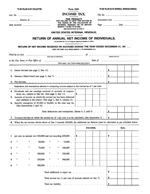U.S. Income Tax Day arrives on April 18 in 2023. And what better way could there be to celebrate the most dreaded day on the American calendar than by filling out another income tax form?
Before you start pounding the "back" button, there's nothing for you to worry about! You won't have to pay any more income taxes than what you already have reported on whichever version of IRS Form 1040 you're filing this year. Instead, we've built the following tool to transport you in time back to 1913, where our tool will estimate how much your federal income taxes would be if that year's income tax rules still applied.
Why 1913? That's the year the Internal Revenue Service first issued its infamous Form 1040. We've modeled our tool after the first page of the original Form 1040, which back then, consisted of just four pages:
- The summary sheet modeled below (Page 1),
- the Gross Income calculation sheet (Page 2),
- the General Deductions sheet (Page 3), and finally,
- one page of Instructions (Page 4).
Yes, you read that right. Paying U.S. income taxes used to only require one page of instructions!
We'll make it even easier. All you need to do is to enter the indicated data (shown in boldface type, in the rows with a white background), using your figures from this year that should still be very fresh in your memory, and we'll take care of the math! The tool will display its calculated results in the rows with a gray background, where you won't have to worry about entering any values.
If you are accessing this article on a site that republishes our RSS news feed, please click here to access a working version of the tool on our site. Now, if you're ready, let's get to it!...
Here are several excerpts from the instructions for filling out the original IRS Form 1040, which explain some of the math our tool is doing.
Excerpts from the Instructions
3. The normal tax of 1 per cent shall be assessed on the total net income less the specific exemption of $3,000 or $4,000 as the case may be. (For the year 1913, the specific exemption allowable is $2,500, or $3,333.33, as the case may be.) If, however, the normal tax has been deducted and withheld on any part of the income at the source, or if any part of the income is received as dividends upon the stock or from the net earnings of any corporation, etc., which is taxable upon its net income, such income shall be deducted from the individual's total net income for the purpose of calculating the amount of income on which the individual is liable for the normal tax of 1 per cent by virtue of this return.
19. An unmarried individual or a married individual not living with wife or husband shall be allowed an exemption of $3,000. When husband and wife live together they shall be allowed jointly a total exemption of only $4,000 on their aggregate income. They may make a joint return, both subscribing thereto, or if they have separate incomes, they may make separate returns; but in no case shall they jointly claim more than $4,000 exemption on their aggregate income.
Previously on Political Calculations
Haven't had enough taxes yet? Here's a couple of other tools that might be of interest to you!
Image credit: Stable Diffusion DreamStudio Beta: "A greedy Uncle Sam wants to make Americans pay taxes".
Welcome to the blogosphere's toolchest! Here, unlike other blogs dedicated to analyzing current events, we create easy-to-use, simple tools to do the math related to them so you can get in on the action too! If you would like to learn more about these tools, or if you would like to contribute ideas to develop for this blog, please e-mail us at:
ironman at politicalcalculations
Thanks in advance!
Closing values for previous trading day.
This site is primarily powered by:
CSS Validation
RSS Site Feed
JavaScript
The tools on this site are built using JavaScript. If you would like to learn more, one of the best free resources on the web is available at W3Schools.com.

